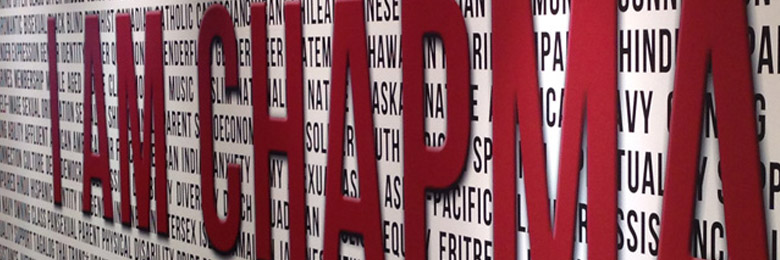
Diversity and Inclusion at Chapman
» Faculty Perspectives
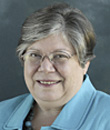
Nina LeNoir
Vice Provost for Undergraduate Education
College of Performing Arts; Department of Theatre
lenoir@chapman.edu
To me, diversity and inclusion means being open. accepting and respecting of people from all walks of life, all cultures, all diverse background and experiences different than your own.
They may look exactly like me but they are not going to have the same experience as me. They may look completely opposite to me and they may be closer to my experience than someone who isn’t. So I try to really not prejudge people. It’s very hard, we’re all, as human beings trying to characterize and classify. It’s just natural instinct. But it is important that we try to be open to receive people and listen to people and experience people from where they’re at. Very hard to do. Easy to say.
At Chapman, I currently take part in the Diversity and Inclusion Curriculum Task Force. I was involved in the steering committee when it first started. Alongside this, because my background is in theatre, I also teach two FFC courses that deal with diversity within the arts. The first one is about Women Playwrights, where in which the students learn about women in the arts, not only playwrights but we also look at women and their place in the arts as well as their opportunities on stages. And we get to read really great plays written by women primarily about experiences of women. The Second FCC I rotate is called Theatre of Diversity. Again we read really great plays by playwrights of all different cultures, and students have a chance to explore a little bit about Native American cultures, African American cultures, Latino/a cultures, gay cultures, transgender culture, and women. We try again to look at the different experiences that people have and be aware what everyone can bring to the table, which is really great.
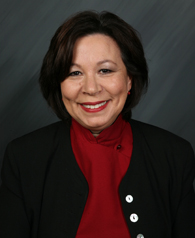
Anaida Colon-Muniz
Professor Of Scholarly Practice
Attallah College of Educational Studies
acolon@chapman.edu
Diversity and inclusion have been my life’s work. As a bilingual and multicultural educator, I have dedicated my professional life to working with English learners and students and parents from diverse backgrounds and communities. When I came to Chapman in 1999, I was hired to prepare teachers in learning how to work with diverse populations.
My research interests include critical bilingual/multicultural education and teacher education, community based education and Latino history of education. From my first experiences as an English learner in New York’s public schools to my awareness of the historical and political underpinnings of my parent’s migration to the States as part of the Puerto Rican diaspora, I have been fascinated with better understanding the history and trajectory of immigrants, Latina women, the schooling of English learners and the formation of their teachers, as well as the struggle for educational rights in Latino communities.
For the last three years I worked collaboratively with colleagues at Chapman as well as local community agencies and organizations to offer early literacy experiences for preschoolers, mentoring for teens and classes for adults. We also host a Latina women’s book club, Saturday story time for kids, and monthly author book signing events and art exhibits-from local talent presenting for the first time, to well-known celebrities and scholars.
Chapman University is trying to create a more inclusive environment aimed at addressing existing inequities and tensions on campus and on a broader level, so as to prepare students who can think globally and act locally in critical ways on the most pressing issues; members of society who would believe in acceptance and tolerance, fairness and social justice, and active participation in constructing a better world.
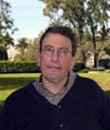
Arthur Blaser
Professor
Wilkinson College of Arts, Humanities, and Social Sciences; Department of Political Science, Department of Peace Studies
blaser@chapman.edu
Diversity in multiple forms is vital to Peace Studies and Political Science in describing what is (too often intolerance of diversity) and in thinking about what could be (enhancing diversity and community). Promoting diversity is central to Chapman's mission, and we all need to be reminded of this.
For the next years, my major research project is writing about the nexus of disability issues with peace and justice issues. Parts of my work deals with access to technology, genocide, veterans, and landmines. My major focus is disabled people, which intersects with gender, ethnic and sexual minorities, etc. The outputs have been conference papers and articles sometimes with student assistance or coauthorship.
I try to recognize diversity in selection of course materials, examples, and outside speakers. We can either provide a narrow view of a complex world or recognize diversity.
Community involvement is very important to me--I learn a lot and hope to make the world a better place. I'm now a board member of Orange County's independent living center.
Students, faculty, and staff have an important role in working to build a community that welcomes and encourages diversity. Our task is to make smaller islands of diversity bigger.
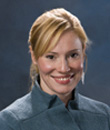
Kelli Fuery
Assistant Professor
Lawrence and Kristina Dodge College of Film and Media Arts
(714) 744-2183
kfuery@chapman.edu
Diversity and Inclusion is a collective pursuit so for me, being a part of Chapman is synonymous with making efforts to participate in a community that includes many views, many voices, all people in an open and respectful environment. Diversity and inclusion is difficult work but at its most effective, and when it is most present, there is recognition that difference is what brings a community together, and that it is what keeps a community moving forward, progressing, becoming more creative. I would never want diversity to mean one thing - indeed as a term it should always be adaptive to whatever the concerns of the culture present themselves. Within any context, but especially that of university, this means I like to consider what, where and how diversity (as a term and as a practice) works. This would include challenging any institutionalization of 'diversity' as a term, particularly one which attaches itself to being recognized through value and appearance. Diversity and inclusion are pathways of transformation, not just of my own research, allowing me the opportunity to consider different collegial perspectives, but equally where I do it.
Everything relates to diversity and and inclusion, however in my research I elect to look at the performativity of representing diversity and inclusion, questioning the ways in which we can be said to know diversity and inclusion 'when we see it'. It is an interesting formulation that diversity requires a visual status when so much of being diverse and feeling included is affective - that is, felt rather than seen. Analyzing films and visual culture, specifically ways in which cultural politics of identity are represented (age, ability, gender, sexuality, race, ethnicity, etc.) is a way to evaluate how diversity becomes practiced and spoken about.
For me, it is only through challenging the ideologies we don't know we have that we can really examine our own views on diversity and inclusion. This means we need to be displaced, to step outside of the normative spaces and places of disciplinary thought and, at times, the space of a classroom context in order to generate that discomfort which results in gaining a new and fresh viewpoint.

Naveen Jonathan
Assistant Professor, Chair & Director of the Marriage and Family Therapy Clinic
Department of Marriage and Family Therapy
jonathan@chapman.edu
As a Marriage & Family Therapist, I am trained in a model that looks at systems thinking and how groups of people interact with one another and also with other groups or systems. This perspective always has me looking at issues such as who has voice and who does not. I teach student to notice these patterns in the therapy room and also in larger society. I train students to be advocates for the clients they serve and assist them in being part of the larger discussion of mental health in the community, state and federal levels. I also teach my students to be global thinkers and train themselves to see that through the education they receive and the profession that they are going into that they have capacity to influence and impact change on many levels in the family and community at large.
Outside of Chapman, I am the Vice-President of an LGBTI Christian organization, called SDA Kinship International. I also am a member of the American Family Therapy Academy, which is an organization that looks at social justice issues in Marriage & Family Therapy. I am involved as a member of the American Association for Marriage & Family Therapy. I am currently the President of the California Division of AAMFT. My Board and I have regularly looked at issues that affect clinicians, educators, students and clients pertaining to diversity and inclusion. I also am involved with the LGBTQA Caucus on the national level as a member. I find that being involved with issues pertaining to LGBTQA people, their relationships and their families and how AAMFT as an organization addresses these issues is important to me.
Diversity and inclusion at Chapman is an area that is continuing to grow and develop. There are many opportunities where individuals can get involved and be a part of the conversation. Every individual’s identity and all the parts that make up who they are valued. I encourage students and faculty to get involved and lend your voice to the discussions around diversity and inclusion. My hope is that with more discussion all of us will feel heard and valued as members of the Chapman family.
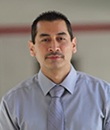
Ruben Espinoza
Assistant Professor & Director
Latinx and Latin American Studies
respinoza@chapman.edu
My commitment to diversity and inclusion is reflected in my teaching, research, and role as Director of Latinx and Latin American Studies. For example, students in my classes interrogate the very idea of Latinx/Latina/Latino. We focus on the unique experiences that these umbrella terms embody, including experiences by indigenous, Afro-Latinx, and LGBTQ+ populations.
Diversity and inclusion are also central to my research. I focus on social inequalities that Latinx people confront in everyday life. My last projected analyzed a farm working community in Central California by highlighting the social borderlands between Latinx citizens, permanent residents, and undocumented migrants in the agricultural industry. By examining diversity and inclusion with a critical lens in research and teaching, we are better prepared to address the exclusions and inequalities that exist in all communities.
As a faculty member at Chapman University, I have an opportunity to mentor students like myself. I am a former reentry and full-time working student, first-generation college graduate, and member of an underrepresented group in academia. These life experiences will be foundational as I shape and grow Latinx and Latin American Studies at Chapman University.

Sally Rubin
Assistant Professor
Dodge College of Film and Media Arts
rubin@chapman.edu
The craft of documentary film is all about inspiring people into action through intimate, human storytelling. Bringing diversity and inclusion into my classroom results in better, more effective films, and a more integrated life experience for my students.
All of my films aim to give voice to the previously unheard. In particular, I bring stories from hidden parts of America to a national audience, putting a human face on today’s relevant social issues.
I believe in the power of representation to instill confidence and a sense of self in my students. It’s important that every one of them see themselves reflected on screen and behind the camera as protagonists and subjects, not just objects of someone else’s gaze.
I participate in Next Step each year as a Faculty Facilitator. I’m also a member of the Curriculum Task Force, a part of the Chapman Diversity Project, a Safe Space trainee, and an out LGBT mentor to my queer and questioning students.
If you’re not getting something you need, tell us. This is your one education- make it what you need.
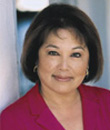
Suzanne SooHoo
Professor Emeritus
Attallah College of Educational Studies
soohoo@chapman.edu
Chapman’s student body and faculty represent different worldviews, different histories and cultural knowledge and should be considered rich resources to the curriculum. By inviting and intentionally including these funds of knowledge, we create a learning context of belonging and becoming. To assume homogeneity or to deny human variance reduces our ability to provide a personalized education as indicated in our Chapman mission.
My two latest books, Culturally Responsive Methodologies (2013) and Relational and Responsive Inclusion (2015) address the questions about how researchers and educators can enhance their abilities to conduct research and to work with different populations by considering culturally responsive practices. Dialogue and reciprocity are central themes that inform our work with and not on Others.
I use critical pedagogy in the classroom that specifically honors epistemological pluralism and thus brings students’ lives and their worldviews as a resource to the curriculum. This active intersection between student lives and course content provides an added dimension of meaning to new content thus helping students to become better meaning makers, critical thinkers and problem solvers.
I work with a group of parent educators and community workers called Padres Unidos. Their mission is to strengthen families in over 30 sites, including Chapman University and OC Juvenile Hall. My doctoral students and I are current conducting a comprehensive program evaluation of their work. Our partnership work will be featured in an upcoming book on Public Sociology by series editors, Victoria McCarty and Raphael Luevano.
At Chapman, anything we have put our collective minds to, we have achieved. Currently, we have an aggressive and comprehensive commitment to excel in diversity and inclusion. I invite prospective members of the Chapman community to join us in building a caring and thoughtful scholarly environment.
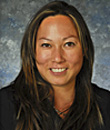
Stephanie Takaragawa
Associate Professor & Associate Dean
Wilkinson College of Arts, Humanities, and Social Sciences; Department of Sociology
takaraga@chapman.edu
Diversity is something that we live with every day, particularly in Southern California. Inclusion is something that we struggle with every day. As an anthropologist, I have studied the histories of inclusion and exclusion that things like culture and ideology are built upon. People naturally tend to come together in groups, to work together and to maintain an identity based on those people that they share values, traditions, histories, etc. Unfortunately, creating groups with like experiences is predicated on exclusion. In my classes I try to find ways to explain how common sense things like culture actually create exclusion in their attempts to create inclusion in order for students to better understand the world that they live in. People tend to think we naturally group together because that is who we are culturally, but when we think about the ways that race, identity and culture are oftentimes culturally constructed, and how aspects of power and privilege are embedded in creating hierarchies and lead to discrimination, those are the teaching and learning moments that I hope to draw attention to.
My research is on Japanese American history and culture, with an emphasis on the Japanese American internment, and how that history has been incorporated into present day exhibitions, museums and monuments. I am also a volunteer with the National Park Service and volunteer at Manzanar National Historic Site in the Owens Valley, a Japanese American internment camp site.
I infuse diversity and inclusion into my classes. I try to emphasize issues of gender and race in the larger American context in all of my courses, with emphasis on media representation. For example, in my visual culture class we look at the history of black presence on television through Marlon Riggs' film Color Adjustment and use Stuart Hall's floating signifier to unpack those issues.